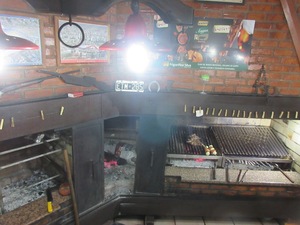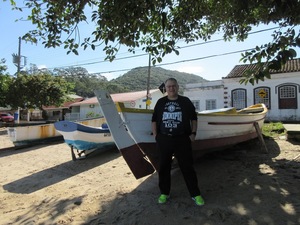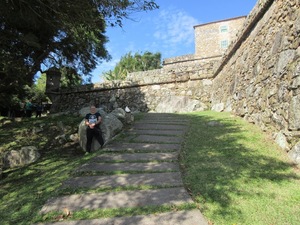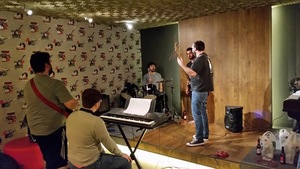You know what, I don’t travel nearly as much as my President & CEO-ish friend Jim Caldwell does, but I managed to rack up a few klicks this spring.
28 April to 03 May: Winnipeg, Manitoba
I zipped back to Winnipeg for a few days to be there for my mom’s 76th birthday. James and his sons were there the week before, so I didn’t have to fight for a bed 🙂
 |
| Happy 76th, Mom – Flowers from Me & Eric, Orchids from James |
I got a chance to visit with Eric and James Douglas, and a brief chat with Sandy.
It wasn’t all fun & games – mom had a serious medical scare while I was there, but it turned out to be a minor issue. Still, it was good that I was there to oversee the excitement, direct traffic, and keep everyone up to date!
21 May to 04 June: Florianopolis Brazil
We have a sister GE/Alstom division Reason Technologia (RTB) in Florianopolis, Brazil – the south of Brazil – where it is winter right now. They design and manufacture complementary equipment to ours here in Phoenix. We are undertaking a joint effort… of course I can’t say much about the details! But I needed to get to Florianopolis to get things kicked off. In mid April, the call came to go visit. Well what do you know, I need a travel visa. Well the visa takes 2 to 4 weeks, and I already have a trip to Winnipeg scheduled for 06 to 18 June (Men’s Camp and other things), so time is tight.
I couldn’t give up my passport until returning from Winnipeg on 03 May, so was pretty tight for a trip. With the passport out for Visa on 04 May, it came back 19 May (two weeks plus overnight transit), and I had planned on that, so was ready for travel to Brazil, plane ticket and all. So… the odyssey begins!
21/22 May: Getting There
Ugh. Well you know that I don’t sleep on planes, mostly because of my sleep apnea and the need for the CPAP machine. Well plus, it’s not all that comfortable in cattle class anyway. So with the 4 hour time difference, a layover in Atlanta and in Sao Paulo, I left Phoenix on Saturday morning and arrived in Florianopolis on Sunday morning. Ugh.
So. Do not assume that anybody in an international airport will speak English. Really. Yikes. Sao Paulo was confusing & difficult. I had a couple of hours, but it was crazy. I think I missed the luggage re-check belt after customs or something. Then I had to try to get my luggage onto the next flight, which, although booked through Delta and having a Delta code share, was actually a Brazilian airline, GOL… which is fine, except being fully Brazilian, very few people speak English. Finally I found the domestic bag drop line and got to the front… and found a woman who spoke a bit of English… and she cleared the way for me to the bag check station and got the bag on its way. Then, back to security, racing to the gate… just in time for the main call for the cabin… poor young ladies sitting beside me, I was sweating profusely from the stress and dashing through the terminal. Oh well, we survived!
Celso, my host colleague at Reason, was leaving Sunday morning for a quick trip to Stafford, England, to meet with other colleagues about another aspect of the same project. He was boarding his plane in Florianopolis while I was getting off of mine. Fortunately, he left me in good hands – Leo, taxi driver who does most of the driving for Reason services, who speaks pretty good English. Hotel. Sleep. Aaaah.
22 May: Where’s the Beef? Everywhere! (and Beer too)
In Celso’s absence, a couple of my other Reason colleagues picked me up later from the hotel and we went for burgers. Bleh, you say – burgers. No, no – these are serious burgers. Amazing. Well crafted, gourmet burgers, quite good. Then you match them up with beer…
 |
| Where’s the beef? Yup, here it is. Beer, too! |
23/24 May: Freezing?
It turns out that I was not prepared for the weather. It’s beautiful, because Florianopolis is an island “almost” attached to the mainland, and jutting into the ocean – but it’s humid, so when it’s +15C overnight, it feels quite chilly. They don’t have heat in the hotel, because, well, if it never dips below +10C, why would you ever need heat?
The first day at the office, on Monday, I nearly froze my tail off. On Tuesday, I wore my light jacket everywhere, but felt kind of silly. So I had Leo take me to a large mall to buy a sweater.
They treated me very well at Reason. And, kept me busy! Between meeting people, learning about their roles, and seeing how their systems & processes work, I barely had time to worry about anything.
Leo drove me everywhere, but I wanted to wander around a bit too.
24 May: At the Mall! Valentine’s Day coming in June?
Yes it was a beautiful evening, Leo took me to the Beira Mar shopping centre. Something like eight stories! But, only 4 levels of stores – the rest is access to parking on all sides. What’s with all the hearts??? Valentine’s Day in June. Well it’s not the same Valentine’s Day as in North America, subtly different, but it’s in June!
 |
| Top Level of Eight |
 |
| Valentine’s Day coming up in June!?! |
|
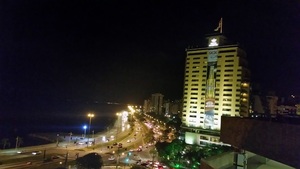 |
| Nighttime view of road along waterfront, from top of Beira Mar shopping centre |
The Credit Card Blues
So we found a sweater that fit me – well, actually two sweaters – and they were a good price – but my US credit card was declined! Both of my US credit cards were declined! Argh! I had to put it on my company Amex. Hope they don’t invoke the “zero tolerance for personal expenses” thing!
One of my US cards is a chip card but I have no PIN, so it was rejected flat out. US banks, in all their wisdom, are using chip & signature instead of the chip & PIN like the rest of the world. The other US card was rejected after a delay. It turns out that they flagged it as a suspicious transaction, in spite of me having called them before going to Brazil. Ugh.
Oh well, the sweaters are nice, and no, there never was a problem with the expense thing. The card is in my name, and I just paid the US$40 myself. I never had any intention of expenses hanky panky.
25 May: Checking out the Manufacturing Plant
Leo took me and two of my Reason colleagues to visit the Reason assembly plant, and their local PCB assembly contract manufacturer. Very cool. Who wouldn’t love those zoot suits?
 |
| Cute Disposable Clothes for Touring the Plant |
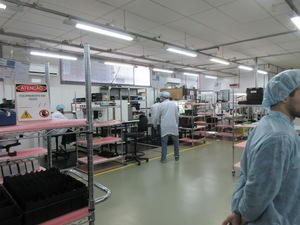 |
| Very Nice Factory Floor at Reason manufacturing plant |
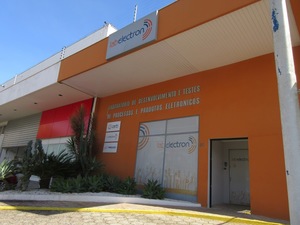 |
| Electronics PCBA CM – Produza |
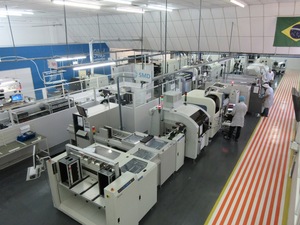 |
| Beautiful Produza Production Floor |
25 May: Surprise, it’s Carlos!
Sandy had mentioned that their family had hosted a young man from Florianopolis some years ago, and asked that I let her know if I met him. Ha ha ha, millions of people, what’s the likelihood of that?
It turns out, pretty likely. His workstation was right behind me the whole time! On our ride out to the manufacturing plant, he asked where I was from. When I said “Winnipeg”, he said, “Oh, I spent a year near there – Carman – do you know where that is?” AAAAAH! Yes I know where that is!
I keep buying lottery tickets, but I can’t beat those odds.
OMG Not going to Starve in Florianopolis!
Yes there were fantastic meals. Lots of meat! When Lucas says meat, he means meat – beef – and lots of it! Here a re a few selected meals – OK not all beef, but always plenty to eat.
26 May: Touring the Island with Lucas and Jamilly
Although I missed the Memorial Day holiday in the USA, the first Thursday in Florianopolis was the Corpus Christi holiday. My colleague Lucas and his girlfriend Jamilly took me on a day-long tour of the north half of the island. It is so beautiful! Although, being winter in the southern hemisphere, it was a little chilly on the beach. I’ve been advised that I have to return in January, when it’s summer, and then I can see how beautiful the women on the beaches – oops, how beautiful the beaches themselves – really are 🙂
28 May: Not-so-successful Cycling Trip (or, Carlos Tries to Kill Me)
Ha ha, after talking to Carlos about the wonders of cycling, he invited me to cycle with him and his friends, 30 km to the south of the island and back, on Saturday morning. Well, it was threatening rain (hmm, it was always threatening rain while I was there) so he decided we’d take the shorter route to the north. Hmm, I just went through there with Lucas and Jamilly yesterday – doesn’t that involve climbing up through a high mountain pass? No worries, just take it easy!
 |
| I don’t look too bad – but looks can be deceiving! |
Well, apparently I do not know how to take it easy. I did not feel good by the time I reached the top. I had to rest, then felt rotten, then worse, then finally improved. It was too much – the heat, humidity, the climb – and not taking it easy. So Carlos’s dad came, picked me up, and took me back to my hotel. So sad. I had a nap then walked a couple of km over to the shopping centre, where I bought some DP and some wine, yay 🙂
29 May: A Lovely Dinner with Celso at Sergio’s Home
The engineering manager, Sergio, invited my colleague Celso and I to dinner with him and his wife. We had a lovely time… what a meal! And, what a house! These photos do not do it justice. Wine, food, yum!
31 May: I Play the Designated Drinker / Garage Band Groupie!
It turns out that Lucas and a few of the other staff at Reason set up their own rock band, and they practice most Tuesday evenings in the “Garage Band Room” in a condominium that one of their relatives lives in. How cool! Lucas claims they don’t play so well, but after a couple of beers, I cannot tell. Still trying to get them on track with BTO’s “Takin’ Care of Business”. They say they will play it next time I am there, ha ha!
The band member selection goes like this: there’s a guy who plays great keyboards, so they make him play the drums. There’s a guy who plays guitar, so they make him play the keyboards. And so it goes. Doesn’t matter, these guys are just getting together and having great fun.
Business? What Business?
Oh yes, and I did attend a few business meetings while I was there.
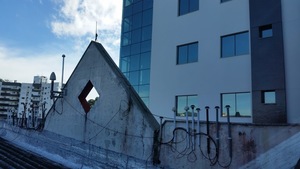 |
| Anybody who complains about my antennas, I’ll show them this picture. |
I happened to notice, out of the top floor conference room window, that Reason has a few antennas on their roof. Something like my roof at home, ha ha.
03/04 June: Travel Back
The return wasn’t quite as tense as the way out. Just as few people spoke English at the Sao Paulo airport, and I almost lost my exit visa (dropped it on floor at bag check and someone handed it back to me) – that would have meant going to a police station and getting a new one! But I didn’t lose it, got to the gate “just” in time but the crew was late because of Sao Paulo traffic in the rain 🙂
Once we landed in Atlanta, well, it all OK, I could understand the language. Although, was a big delay in customs because I have to go in the “all others” line on account of my work visa – not the “US and Canadian Passports” line – made that mistake once – just once. I was behind a lot of people who spoke only Portuguese. They kept calling for Spanish interpreters at the wickets – joke’s on them, Spanish is not Portuguese.
Some poor folks didn’t understand the English directions, and forgot to dump their big items back onto the checked luggage conveyor – tried to get through the bag check line with big items – don’t know what happened, but staff tried to tell them again and again, didn’t seem to help. Sigh. I was tired but OK.
I got upgraded to first class on the last segment of the trip. It was nice, because ugh was I tired. That was a nice touch.
I got home and thought I would sleep for a week, but I didn’t – only for about 14 hours. Then off to church, the next day at work, and after that, off to Winnipeg!
06 June to 18 June: Winnipeg Manitoba
Yes, it was time for my annual June trek back to Winnipeg for Men’s Camp and other fun things.
I had to renew my passport, and get a new 3 year TN work visa.
While getting back to the car from picking up my passport, I spotted this scene that felt like a throwback – hidden in downtown Winnipeg!
10 & 11 June: Men’s Camp 2016 – the Last One
Yes, attendance has been dwindling. We’ve lost so many of our older attendees who pass on each year, more in ill health and can’t get away for the weekend, and others still who have such hectic lives that they can’t make it out. So this year, we did it – we closed down Riding Mountain Conference of Churchmen. Sigh. 51 years. It was a good topic, very much enjoyed. But that’s it.
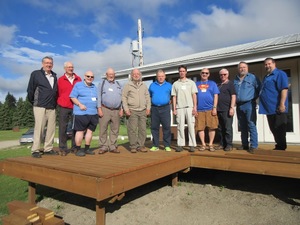 |
| Attendees at the 51st and Last Men’s Camp |
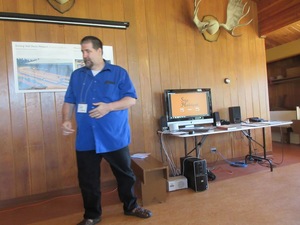 |
| James Douglas, in full flight! |
 |
| Tim Olfrey sharing a devotion |
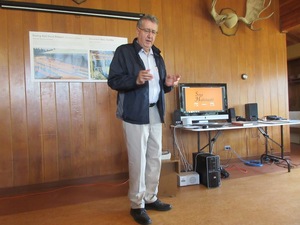 |
| Harvey Douglas, chair of last Men’s Camp |
 |
| Speaker Presentation |
 |
| Path to the Lakeshore… kind of like life… can’t see clear path, but that’s OK! |
 |
| Clear Lake |
09 June: Getting the Call to Go to France
I had a suspicion that I might have to go to France, or maybe do some tech support from Winnipeg, so as a minimum, I brought my office desktop computer. Good thing. Within a few days of arrival, I was asked to go to France immediately to work on RTE Poste Intelligent installation.
My passport was out for renewal, so I couldn’t go right away, at least until I got it back. That would have been the 2nd Tuesday. I had a lot of arrangements to make, that would have taken up my Wednesday. I couldn’t fly until Thursday… that means I would arrive on Friday afternoon… just in time to take the weekend off (no working in France on Saturday).
I took no clothes with me to Winnipeg, as I keep clothes at my mother’s place. I just had a little carry-on that I used to carry the computer, my CPAP machine, tablet and a few other things. I had to go buy a suitcase in Winnipeg and take almost all of the clothes from my mother’s. Hmm, the two pairs of pants that were there were rather ratty, so I bought two new pairs of pants too.
I also had to buy power adapters (just in case mine from Phoenix didn’t arrive – still need to run my CPAP), and snagged magnifying glasses and safety glasses…
So, I finished out my week, went through the Emerson/Pembina border crossing on Friday afternoon and got my TN visa, and stayed with Eric in Grand Forks overnight. That let us go to the races!
17 June: World of Outlaws
I booked advance seats, so we got a prime spot, up high, down to the west end. Not perfect, mind you – that would be further to the west, with the sun setting behind us – but they were pretty good. Lots off thrills, spills, and yellow flags! We had fun.
18 June: Flying Away
On Saturday, instead of driving further down the road to Fargo and flying back to Mesa, I left directly out of Grand Forks, through Minneapolis-St. Paul, and off to France. Yikes.
19 June to 24 June: Rouen France
Taxi! Taxi!
Mehamed told me that there was no way that I’d get a rented car in France, since the Euro Cup football (what we call soccer) tournament was on. Not a single rented car in France, wow. Not that I wanted to drive in France – I don’t know the region, don’t know French all that well (not well enough to make decisions at 110 km/hr), and the road signs are different – not a great recipe for success. So, Mehamed arranged a taxi & driver for me. But, he said to bring ca$h with me. Yup, 1000 € in cash! Ouch.
Money Changing and Stupid Credit Card Tricks!
So 1000 € is a lot of money – something like CA1500 or more. Where am I going to get that? Well, there’s a big money changing place in downtown Winnipeg, they can easily do it. I went downtown, paid for parking, waltzed in, and asked for 1000 €. No problem. I have CA1500 in cash? Heck no! Well then, off to the airport with you. Sigh.
At the airport, I tried to use my corporate American Express. Nope. My personal USA Visa. Nope. So I did a cash advance on my personal Canadian Visa. Ouch. Oh well, I’ll expense it later.
When I got to France, I found out that American credit cards just don’t work well there. I learned my lesson last year in France, and recently in Brazil, and took my Canadian Visa with me, just in case. I would guess that 3/4 of the time, the American Express card was flatly turned down. The rest of the time, only say 1/10 of the time did either one of my USA Visa cards work. Most of the time, I had to use cash, or put it on my Canadian Visa. My Canadian debit card worked like a champ too, then again, I don’t have much in that account to draw on… so Visa it was!
A Personal Driver with Car
It turned out that Mehamed arranged for a private car with driver, for me personally. He picked me up at the airport and drove me directly to Rouen, where I was staying, about a 2-3 hour drive west out of Paris.
Now, Hocine, the driver, spoke very little English. Oy. And my French isn’t very good. I’ll tell you though, my French got better over the 5 days I was there! Thank God for Google Translate, which I have on my phone. When I was stuck, I’d get it to translate, either way. It worked fairly well. There were times though, when he spoke so quickly that I was completely lost. It was a bit frustrating at times, but we got along OK.
It was quite convenient and efficient, but also expensive. Total cost was just under 1500 €… in cash! I had to use French bank machines three times to get further cash advances on my Canadian Visa. Ouch!
Rouen – A Magnificent City with History
The hotel that I stayed at was literally 1/2 block away from the Rouen Cathedral. What a magnificent building! Unfortunately, I didn’t get inside – I slept a bit on Sunday afternoon after getting to Rouen, and by the time I was up & around again, it was closed for the day.
Hocine is from just outside Rouen, and is quite proud of the area. He picked me up later in the afternoon and gave me a brief tour of the city, including a lookout where I could look down on all of Rouen.
Dieppe – A Beautiful Coastal City
On Monday evening, Hocine insisted that I had to see more of France. We did a small detour to Dieppe. It was unseasonably cold, but still quite nice. Again, so much history.
Apparently, this is a very romantic town – the place for lovers to go. Hmmm 🙂
Work on Remote Site
The actual work site is well north of Rouen, actually closer to Amiens. It’s about a 45 to 55 minute drive each way, right near Restaurant le Coq Gaulois at Gauville.
Briefly in Paris
Travel




 WARNING! The following command will remove all data on the partition that you are encrypting. You WILL lose all your information! So make sure you backup your data to an external source such as NAS or hard disk before typing any one of the following command.
WARNING! The following command will remove all data on the partition that you are encrypting. You WILL lose all your information! So make sure you backup your data to an external source such as NAS or hard disk before typing any one of the following command.












